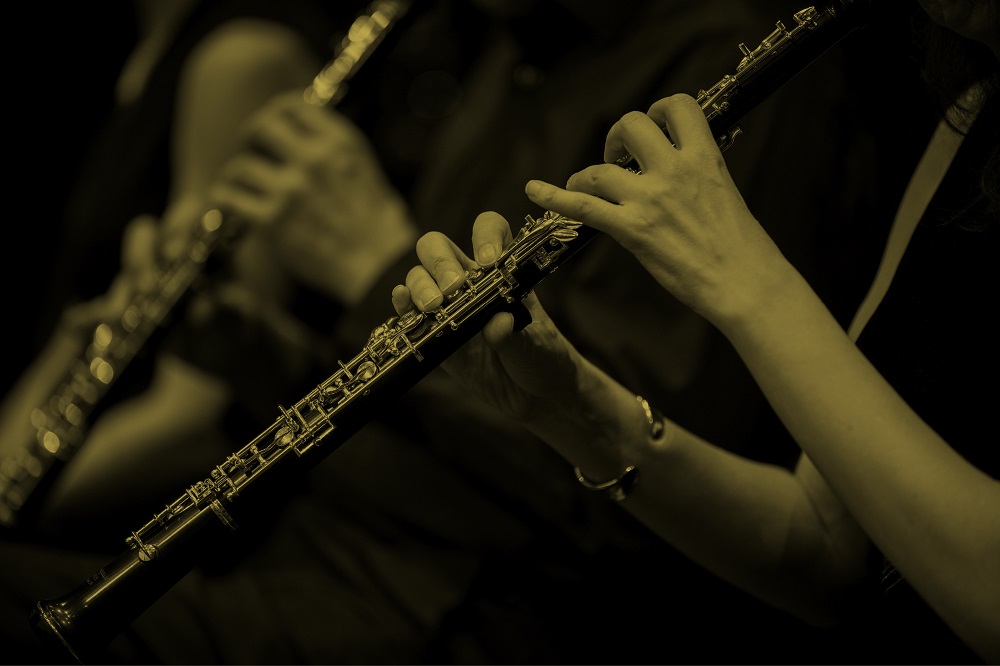Scottish Chamber Orchestra, Queen's Hall, Edinburgh online review – two Parisian gems | reviews, news & interviews
Scottish Chamber Orchestra, Queen's Hall, Edinburgh online review – two Parisian gems
Scottish Chamber Orchestra, Queen's Hall, Edinburgh online review – two Parisian gems
Salon music – but only from your own salon

Though live performances are, thankfully, starting to reappear throughout the country, and socially distanced seating, mask-donning and constant hand sanitising becomes the norm for audiences south of the border, those in Scotland are still eagerly anticipating the opportunity to once again be in a concert hall experiencing live music first hand.
SCO flautist André Cebrián introduced the Poulenc, describing it as ‘an exciting trip to the cafes, cabarets and jazz clubs of Paris of the ‘30s, with plenty of humour and irony.’ Motifs inspired by music halls and circuses abound, and the rambunctious spirit of the piece was evident from the very first chord. Clarinettist Maximiliano Martin’s pithy, punchy passages in the first movement were beautifully matched with more delicate playing from Cebrián on flute, and Alison Green on bassoon. As the music grew warmer and only slightly less irreverent, Cebrián’s feathery flutter-tonguing was well balanced with delicate keyboard playing from Simon Smith. The raucous fun soon resumed, as the movement ended with a stylish flourish.
The middle movement takes on a more reserved style, with much heavily borrowed from Mozart, but given Poulenc’s witty twist. The players perfectly capture the music’s mood, with a few cheeky nods offsetting its apparent tranquillity. The prestissimo finale had a spiky, boisterous opening, though its more ponderous end section perhaps stood out more, with each players’ lines beautifully melting into one-another, culminating in a surprisingly elegant ending.  Moving on to another Parisian composer, Louise Farrenc, the winds were joined on stage by one of each orchestral string instrument for what Cebrián – who also introduced this work – described as a "symphony in miniature".. Indeed, despite being scored for only nine players, Farrenc’s nonet is a vividly detailed musical canvas brimming with colour, with the group onstage producing a full sound which belied their number. Playing with innate synchronicity, the piece began with marked, stiking string chords punctuated by delicate woodwinds. The first movement – and the work’s longest – was played with a mature poise, with beautiful singing passages from violinist Kana Kawashima.
Moving on to another Parisian composer, Louise Farrenc, the winds were joined on stage by one of each orchestral string instrument for what Cebrián – who also introduced this work – described as a "symphony in miniature".. Indeed, despite being scored for only nine players, Farrenc’s nonet is a vividly detailed musical canvas brimming with colour, with the group onstage producing a full sound which belied their number. Playing with innate synchronicity, the piece began with marked, stiking string chords punctuated by delicate woodwinds. The first movement – and the work’s longest – was played with a mature poise, with beautiful singing passages from violinist Kana Kawashima.
The Andante con moto certainly had a fair bit of movement, though the overall pace felt relaxed, with flurried movements in the winds balanced by more leisurely strings, and vice-versa. The third, scherzo movement, had an energy so infectious I momentarily forgot I was only seeing the musicians via a screen. The violin's and cello’s pizzicato gave the movement’s opening minor bars a stealthy edge, before the music took a resplendent shift to major. The continuous shifts between major and minor were executed with zest and vigour, before the more reverent finale, which was played with poise, gravity and depth.
While of course the regulations in Scotland surrounding live performance make things difficult, both practically and emotionally, for performers, managers, critics and audience alike, it was still a treat to hear this salon-style music played live, in the comfort of my own salon, and to see the Queen’s Hall filled with music once more.
rating
Explore topics
Share this article
The future of Arts Journalism
You can stop theartsdesk.com closing!
We urgently need financing to survive. Our fundraising drive has thus far raised £49,000 but we need to reach £100,000 or we will be forced to close. Please contribute here: https://gofund.me/c3f6033d
And if you can forward this information to anyone who might assist, we’d be grateful.

Subscribe to theartsdesk.com
Thank you for continuing to read our work on theartsdesk.com. For unlimited access to every article in its entirety, including our archive of more than 15,000 pieces, we're asking for £5 per month or £40 per year. We feel it's a very good deal, and hope you do too.
To take a subscription now simply click here.
And if you're looking for that extra gift for a friend or family member, why not treat them to a theartsdesk.com gift subscription?
more Classical music
 Willis-Sørensen, Ukrainian Freedom Orchestra, Wilson, Cadogan Hall review - romantic resilience
Passion, and polish, from Kyiv's musical warriors
Willis-Sørensen, Ukrainian Freedom Orchestra, Wilson, Cadogan Hall review - romantic resilience
Passion, and polish, from Kyiv's musical warriors
 BBC Proms: The Marriage of Figaro, Glyndebourne Festival review - merriment and menace
Strong Proms transfer for a robust and affecting show
BBC Proms: The Marriage of Figaro, Glyndebourne Festival review - merriment and menace
Strong Proms transfer for a robust and affecting show
 BBC Proms: Faust, Gewandhausorchester Leipzig, Nelsons review - grace, then grandeur
A great fiddler lightens a dense orchestral palette
BBC Proms: Faust, Gewandhausorchester Leipzig, Nelsons review - grace, then grandeur
A great fiddler lightens a dense orchestral palette
 BBC Proms: Jansen, Royal Concertgebouw Orchestra, Mäkelä review - confirming a phenomenon
Second Prom of a great orchestra and chief conductor in waiting never puts a foot wrong
BBC Proms: Jansen, Royal Concertgebouw Orchestra, Mäkelä review - confirming a phenomenon
Second Prom of a great orchestra and chief conductor in waiting never puts a foot wrong
 BBC Proms: Royal Concertgebouw Orchestra, Mäkelä review - defiantly introverted Mahler 5 gives food for thought
Chief Conductor in Waiting has supple, nuanced chemistry with a great orchestra
BBC Proms: Royal Concertgebouw Orchestra, Mäkelä review - defiantly introverted Mahler 5 gives food for thought
Chief Conductor in Waiting has supple, nuanced chemistry with a great orchestra
 Dunedin Consort, Butt / D’Angelo, Muñoz, Edinburgh International Festival 2025 review - tedious Handel, directionless song recital
Ho-hum 'comic' cantata, and a song recital needing more than a beautiful voice
Dunedin Consort, Butt / D’Angelo, Muñoz, Edinburgh International Festival 2025 review - tedious Handel, directionless song recital
Ho-hum 'comic' cantata, and a song recital needing more than a beautiful voice
 Classical CDs: Dungeons, microtones and psychic distress
This year's big anniversary celebrated with a pair of boxes, plus clarinets, pianos and sacred music
Classical CDs: Dungeons, microtones and psychic distress
This year's big anniversary celebrated with a pair of boxes, plus clarinets, pianos and sacred music
 BBC Proms: Liu, Philharmonia, Rouvali review - fine-tuned Tchaikovsky epic
Sounds perfectly finessed in a colourful cornucopia
BBC Proms: Liu, Philharmonia, Rouvali review - fine-tuned Tchaikovsky epic
Sounds perfectly finessed in a colourful cornucopia
 BBC Proms: Suor Angelica, LSO, Pappano review - earthly passion, heavenly grief
A Sister to remember blesses Puccini's convent tragedy
BBC Proms: Suor Angelica, LSO, Pappano review - earthly passion, heavenly grief
A Sister to remember blesses Puccini's convent tragedy
 BBC Proms: A Mass of Life, BBCSO, Elder review - a subtle guide to Delius's Nietzschean masterpiece
Mark Elder held back from blasting the audience with a wall of sound
BBC Proms: A Mass of Life, BBCSO, Elder review - a subtle guide to Delius's Nietzschean masterpiece
Mark Elder held back from blasting the audience with a wall of sound
 BBC Proms: Le Concert Spirituel, Niquet review - super-sized polyphonic rarities
Monumental works don't quite make for monumental sounds in the Royal Albert Hall
BBC Proms: Le Concert Spirituel, Niquet review - super-sized polyphonic rarities
Monumental works don't quite make for monumental sounds in the Royal Albert Hall
 Frang, Romaniw, Liverman, LSO, Pappano, Edinburgh International Festival 2025 review - sunlight, salt spray, Sea Symphony
Full force of the midday sea in the Usher Hall, thanks to the best captain at the helm
Frang, Romaniw, Liverman, LSO, Pappano, Edinburgh International Festival 2025 review - sunlight, salt spray, Sea Symphony
Full force of the midday sea in the Usher Hall, thanks to the best captain at the helm

Add comment